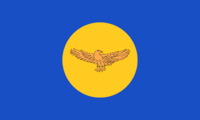Early states of Byasa
The warring states period of Byasanese history (also called the early states period) lasted from the end of prehistory in Byasa until 1006 CE with the formation of the Bhuti dynasty. It was characterized by unstable and unclear political borders, typical of other similar proto-states of the early centuries CE. Early dynasties developed c. the 2nd century CE after the introduction to the concept by merchants from the Han dynasty of Monsilva.
Overview
The warring states period began in c. 600 BCE and ended in 1006 CE. Proto-states have existed in Byasa since the beginning of the Bronze Age in c. 1000 BCE, but the first actual state didn't develop until c. 500 BCE. The state, named Chamdo A, was a part of the Chamdo proto-culture group of states that existed from 500 BCE until about 100 CE. The states did not have anything to do with Chamdo—the proto-culture was named for the area it was located in. The states of the proto-culture were essentially in a state of perpetual war with each other, and territorial claims were nebulous at best. The proto-culture encompassed a total of six states, stretching from near the northern tip of modern Byasa to north-central Nagstsalachen province.
At the same time, Şovunkyn tribal states similar to those in Uulgadzar began to form. These states were a part of the Rigrongseb proto-culture—once again named after the modern-day area the proto-culture was located in. The five states that were a part of this proto-culture stretched from inside the modern-day Hoydgadzar province of Uulgadzar to the center of the Derixörs province of Byasa. The largest of the five states was Rigrongseb C, which was located generally in the same area as modern-day Rigrongseb. This period with the formation of states is known as the Lower Warring States Period.
Starting in the 2nd century CE, dynasties began to form in the area of the Chamdo proto-culture. Chamdo C is believed to have developed into the first dynasty in Byasanese history, named the Palsang dynasty. Two other dynasties developed as well—the Damdul dynasty from Chamdo A in the 3rd century and the Namdak dynasty from Chamdo F in the 6th century. In the area of the Rigrongseb proto-culture, two formed—the Tutei dynasty from Rigrongseb C in the 5th century and the Telegetu dynasty from Rigrongseb B in the 6th century. By the 7th century, all states on record had consolidated into dynasties. This period with the formation of dynasties is known as the Middle Warring States Period.
In the 8th century, a mysterious collapse occurred where all dynasties disappeared from the historical record. In fact, written records from the era between the 8th century and the formation of the Bhuti dynasty in the 11th century are almost completely non-existent. Several theories exist, however only two have significant archaeological evidence in support of them. The first and most popular is that the dynasties all went to war with each other and all collapsed almost simultaneously after the war ended. The second theory is that an external invading force entered Byasa and destroyed the dynasties. This theory has historically been disregarded, however in recent times the theory has earned credence after archaeological findings revealed there were people in the area of the Chamdo dynasties who did not originate in Byasa or Monsilva and existed around the same period of the collapse. This period is known as the Upper Warring States Period.
The warring states period ended in the 11th century with the formation of the Bhuti dynasty.
